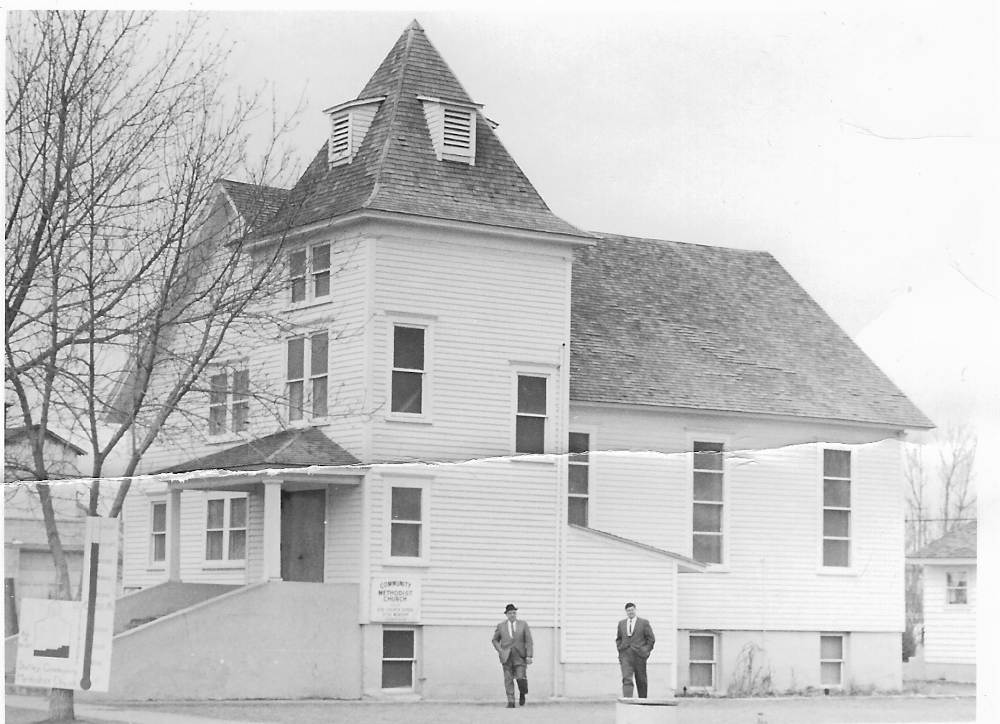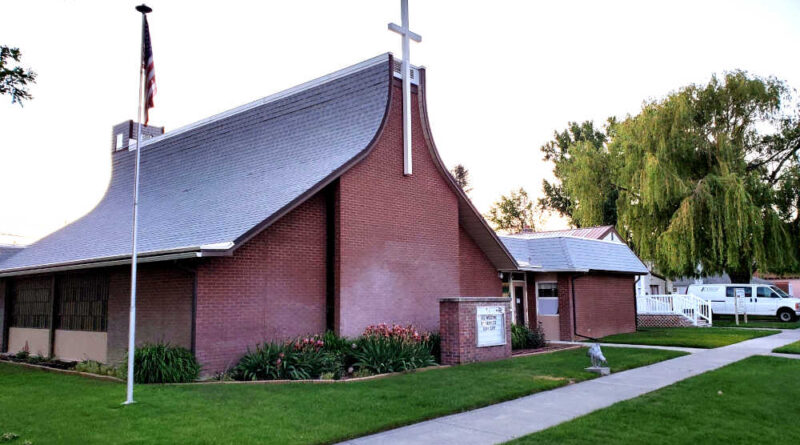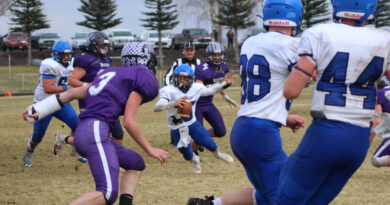Shelley losing historical church
SHELLEY — At the end of June, a place of worship will pass into history as the Shelley Community United Methodist Church closes down.
The congregation lost their beloved pastor, Davey Lefler, when he passed away in December 2019. A retired Presbyterian Pastor visited the Shelley congregation once a month to offer members an opportunity to take Communion and hear a sermon. But, with the outbreak of COVID-Â19, the church was closed to services entirely. Earlier this year, the General Conference, the Council of Bishops and the Judicial Council decided to close the church permanently.
It has been a long goodbye as the membership had dropped to 19 members, with only about seven of them actively engaged. In past years the church was a vital and active force for good woven into the fabric of small-town life.
The Methodist Episcopal Church in Shelley was founded Aug. 3, 1902, with Rev. W.W. Van Dusen serving as the presiding elder and Rev. H.E. Carter as pastor. There were five members, but the pastor didn’t stay long and the group met in homes. It was organized a second time in 1910 when John E. Williams of the Kentucky Conference came to town. They met in a Lutheran church with a congregation of 14 members. Williams stayed less than a year, but he left a thriving church of 28 members, an official board, a splendid Ladies Aid Society, three Sabbath schools (101 students in Sunday School) and a central corner lot for a new church building. He was paid $410. The congregation did not get a permanent building until June of 1915. The lot on the corner of Pine Street and Holmes Avenue and was purchased from John Lundell for $400. He then donated $75 to the building fund.
(The following information regarding the church’s history was taken from an article written by Hortense Hanson in The Shelley Pioneer published Sept. 27, 1973. Longtime church members Ethel Puskar and the Neal Sage family assisted in gathering the material.)
Neal S. Sage came to Shelley from Iowa (one account says he came from Kansas) in 1905. After a correspondence courtship, he proposed marriage to a young woman named Madge. She joined him and they were married in 1906. In 1908 he returned to the Midwest and gathered a group of about 25 people interested in coming west. Sage represented a real estate company, which offered to pay the train fare of those who bought farmland; those who didn’t buy land had to pay their own train fare. The Shelley Pioneer newspaper ran an editorial noting that the caravan consisted of 15 touring coaches for the farmers and the necessary freight cars to transport their livestock, machinery, and household goods. This group who settled in the area were the first members of the Shelley Methodist Church.
They wanted to find a way to worship. Sage, who was also a banker, noticed the need for a building and started to get donations to build a community church. The Ladies Aid Society, with its 19 original members, served dinners, held bazaars and did other projects to add to the building fund. Eventually, the organization donated the pews for the building.
The church was constructed from plans originally drawn by Henry Lee Malcom, who had built a church in Normal, Illinois. When he moved to Shelley, he brought the blueprints with him and built another church just like it. Malcom did the cement work and men from the congregation framed the building under his supervision. Ed Jeppson, who had helped Malcom back in Illinois, came west and assisted with the finishing work.

When the contractor’s workers were idle, Malcom put them to work on the new church, and soon the membership had its own place of worship.
According to Sage, the building was “mortgaged to the hilt in order to get it finished.†The basement was finished and furnished in the fall of 1914, so services could be held in the winter. Less than a year later, the completed church was dedicated with Reverend Mark White as pastor. An organ was purchased at a farm sale for $25.
The church struggled but managed to meet financial obligations during the First World War as several of its members served in the military. An entry by one Rudolph Voling in the old record book noted, “Left to get the Kaiser, August 10, 1918.â€
After a dedicated fundraising effort, the loan on the church was paid off and a celebration at the church was held on Dec. 5, 1926. The note was burned at the morning Sunday School services, followed by special music and a basket dinner for families and friends.
Although no dollar amount was given for the church construction, Malcom built a town hall in 1913 and sheds light on the costs of things in those days. The Shelley Village Board agreed to pay him $4.50 per day, not to exceed $1,250, including material and labor. That building had a brick exterior, a jail room, corridor and engine room, with a four-inch-thick cement floor.
During the Great Depression, the church survived, but just a few pennies were the typical Sunday offering. Many people lost jobs and the area had seven years of grasshoppers, poor prices for farm crops and a major drought. The typical home mortgage was $15 to $20 a month, but many could not make payments. It was hard to pay a pastor and many didn’t stay very long. But at the height of the Depression, Rev. Ruth B. King came on as a full-time pastor. She started a vacation Bible School, revival meetings, Easter services, a fathersâ€andÂâ€sons banquet and special song services two Sundays per month, as well as a junior choir. Boy Scouts and Girl Scouts were church-Âsponsored.
Decades later, fundraising began for a new building and a beautiful new brick church was completed in 1968. Financial times were better, but the congregation still sacrificed to contribute to the building fund. Its beautiful stained glass windows made the sanctuary a breathtaking place where many weddings and special services, funerals and choir programs were held regularly. The new church was built on the same location after the original church was demolished. It has been a mainstay of the community.
Two of the church’s most recent pastors, Rev. Michael Eld and Rev. Davey Lefler provided longâ€term stability and increased the church membership and its outreach The church sponsored the non-Âprofit North Bingham County Community Foodbank in Shelley, beginning in 1990, transforming its former parsonage home into a storage facility that served the needs of foodÂâ€insecure families. Phyllis Taylor, Dorothy Snarr and Freda Leatham originated the food bank. The generosity of the population around Shelley and Firth have sustained it, including its two large food drives from the Boy Scouts of America and the Letter Carriers of the U.S. Postal Service. Volunteers have donated thousands of hours of service, led by its directors, Sally Hartert and more recently, Beverly Peeler. Peeler and Heidi Schultz headed up the Angel Tree project to help supply Christmas gifts for needy children and senior citizens beginning in 1995 as part of the food bank.
“It’s hard to see the church close, but it is not a church anymore,†Peeler said recently. “We just hope it will be a place that can be useful in the community as a place to hold weddings, meetings, dinners and celebrations. It holds many great memories.â€
The work of the food bank will continue as the Heart2Hand Bingham Food Pantry, which will begin management of the pantry July 1, 2021.






Thanks for the interesting historical report!
Lots of good memories at this church. My parents (Ralph and Carol Berenger) bought the Shelley Pioneer and moved to town in the late 1970s. The Methodist Church parsonage was our first home. My parents speak fondly of the house; they used to address newspapers in the study of the parsonage, using a hand fed stamping machine, while I slept in my crib. I was very young, but my very first memories were in that house. I was 4 years old when the church got its new minister, and my parents bought a house on the outskirts of town near Curtis Brinkman Park. My Mom was Catholic and my Dad was Methodist so we split our time between the two parishes. We supported a lot of events and fundraisers at the church. I remember playing in the kids room, helping make paper flowers for Cinco De Mayo, and attending Girl Scout meetings at the church. Amazing memories. I’m sad to hear the church is closing, but am hopeful the good work they started will continue for the community.